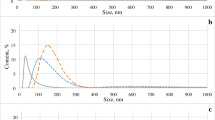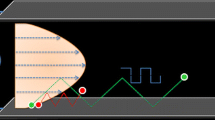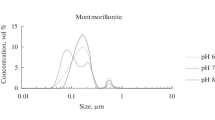Abstract
Coiled tube field-flow fractionation (CTFFF) is currently applied to environmental and material studies. In the present work, a novel zone elution mode in CTFFF has been proposed and developed. Zone elution mode is based on the separation of particles by stepwise decreasing the flow rate of the carrier fluid and their subsequent elution at a constant flow rate. The fractionation parameters were optimized using a mixture of standard silica submicron particles (150, 390, and 900 nm). Taking samples of volcanic ash as examples, it has been demonstrated that zone elution mode can be successfully used for the fractionation of environmental nano- and submicron particles. For the first time, CTFFF was coupled online with a dynamic light scattering detector for the size characterization of eluted particles. Zone elution in CTFFF can serve for the further development of hyphenated techniques enabling efficient fractionation and size/elemental characterization of environmental particles in nano- and submicrometric size ranges.
Graphical abstract





Similar content being viewed by others
References
Laborda F, Bolea E, Cepriá G, Gómez MT, Jiménez MS, Pérez-Arantegui J, Castillo JR. Detection, characterization and quantification of inorganic engineered nanomaterials: a review of techniques and methodological approaches for the analysis of complex samples. Anal Chim Acta. 2016;904:10–32. https://doi.org/10.1016/j.aca.2015.11.008.
Fedotov PS, Vanifatova NG, Shkinev VM, Spivakov BYa. Fractionation and characterization of nano- and microparticles in liquid media. Anal Bioanal Chem. 2011;400:1787–1804. https://doi.org/10.1007/s00216-011-4704-1.
Krystek P, Ulrich A, Garcia CC, Manohar S, Ritsema R. Application of plasma spectrometry for the analysis of engineered nanoparticles in suspensions and products. J Anal At Spectrom. 2011;26:1701. https://doi.org/10.1039/c1ja10071h.
ISO/TS 80004-2:2015 – Nanotechnologies – Vocabulary – Part 2: Nano-objects. International Organization for Standardization. 2015:10
Buffle J, van Leeuwen HP (eds.). Environmental particles. Vol. 1. (IUPAC Environmental analytical and physical chemistry series). Boca Raton: Lewis Publishers; 1992. p. 554.
López-Sanz S, Fariñas NR, Martín-Doimeadios R del CR, Ríos Á. Analytical strategy based on asymmetric flow field flow fractionation hyphenated to ICP-MS and complementary techniques to study gold nanoparticles transformations in cell culture medium. Anal Chim Acta. 2019;1053:178–185. https://doi.org/10.1016/j.aca.2018.11.053.
Montaño MD, von der Kammer F, Cuss CW, Ranville JF. Opportunities for examining the natural nanogeochemical environment using recent advances in nanoparticle analysis. J Anal At Spectrom. 2019;34:1768–72. https://doi.org/10.1039/C9JA00168A.
Dutschke F, Irrgeher J, Pröfrock D. Optimisation of an extraction/leaching procedure for the characterisation and quantification of titanium dioxide (TiO 2) nanoparticles in aquatic environments using SdFFF-ICP-MS and SEM-EDX analyses. Anal Methods. 2017;9:3626–35. https://doi.org/10.1039/C7AY00635G.
Radebe NW, Beskers T, Greyling G, Pasch H. Online coupling of thermal field-flow fractionation and Fourier transform infrared spectroscopy as a powerful tool for polymer characterization. J Chromatogr A. 2019;1587:180–8. https://doi.org/10.1016/j.chroma.2018.12.012.
Pergantis SA, Jones-Lepp TL, Heithmar EM. Hydrodynamic chromatography online with single particle-inductively coupled plasma mass spectrometry for ultratrace detection of metal-containing nanoparticles. Anal Chem. 2012;84:6454–62. https://doi.org/10.1021/ac300302j.
López-Sanz S, Fariñas NR, Zougagh M, Martín-Doimeadios R del CR, Ríos Á. AF4-ICP-MS as a powerful tool for the separation of gold nanorods and nanospheres. J Anal At Spectrom. 2020;35:1530–1536. https://doi.org/10.1039/D0JA00123F.
Kruszewska J, Matczuk M, Skorupska S, Grabowska-Jadach I, Hernández EP, Timerbaev A, Jarosz M. Characterization of quantum dots in cancer cytosol using ICP-MS-based combined techniques. Anal Biochem. 2019;584:113387. https://doi.org/10.1016/j.ab.2019.113387.
Faucher S, Ivaneev AI, Fedotov PS, Lespes G. Characterization of volcanic ash nanoparticles and study of their fate in aqueous medium by asymmetric flow field-flow fractionation–multi-detection. Environ Sci Pollut Res. 2021;28:31850–31860. https://doi.org/10.1007/s11356-021-12891-0.
Lespes G, Gigault J. Hyphenated analytical techniques for multidimensional characterisation of submicron particles: a review. Anal Chim Acta. 2011;692:26–41. https://doi.org/10.1016/j.aca.2011.02.052.
Ivaneev AI, Ermolin MS, Fedotov PS, Faucher S, Lespes G. Sedimentation field-flow fractionation in thin channels and rotating coiled columns: from analytical to preparative scale separations. Sep Purif Rev. 2021;50:363–79. https://doi.org/10.1080/15422119.2020.1784940.
Giddings JC. A new separation concept based on a coupling of concentration and flow nonuniformities. Sep Sci. 1966;1:123–5. https://doi.org/10.1080/01496396608049439.
Baalousha M, Stolpe B, Lead JR. Flow field-flow fractionation for the analysis and characterization of natural colloids and manufactured nanoparticles in environmental systems: a critical review. J Chromatogr A. 2011;1218:4078–103. https://doi.org/10.1016/j.chroma.2011.04.063.
Giddings JC. Field-flow fractionation: analysis of macromolecular, colloidal, and particulate materials. Science. 1993;260:1456–65.
Cölfen H, Antonietti M. Field-flow fractionation techniques for polymer and colloid analysis. Berlin, Heidelberg: Springer; 2000. p. 67–187.
Ivaneev AI, Faucher S, Ermolin MS, Karandashev VK, Fedotov PS, Lespes G. Separation of nanoparticles from polydisperse environmental samples: comparative study of filtration, sedimentation, and coiled tube field-flow fractionation. Anal Bioanal Chem. 2019;411:8011–21. https://doi.org/10.1007/s00216-019-02147-9.
Ermolin MS, Fedotov PS, Malik NA, Karandashev VK. Nanoparticles of volcanic ash as a carrier for toxic elements on the global scale. Chemosphere. 2018;200:16–22. https://doi.org/10.1016/j.chemosphere.2018.02.089.
Ermolin MS, Fedotov PS, Ivaneev AI, Karandashev VK, Fedyunina NN, Burmistrov AA. A contribution of nanoscale particles of road-deposited sediments to the pollution of urban runoff by heavy metals. Chemosphere. 2018;210:65–75. https://doi.org/10.1016/j.chemosphere.2018.06.150.
Ermolin MS, Fedotov PS, Ivaneev AI, Karandashev VK, Fedyunina NN, Eskina V. Isolation and quantitative analysis of road dust nanoparticles. J Anal Chem. 2017;72:520–32. https://doi.org/10.1134/S1061934817050057.
Ermolin MS, Ivaneev AI, Fedyunina NN, Karandashev VK, Burmistrov AA, Fedotov PS. Natural silicate nanoparticles: separation, characterization, and assessment of stability and perspectives of their use as reference nanomaterials. Anal Bioanal Chem. 2021;413:3999–4012. https://doi.org/10.1007/S00216-021-03351-2/TABLES/2.
Fedotov PS, Ermolin MS, Katasonova ON. Field-flow fractionation of nano- and microparticles in rotating coiled columns. J Chromatogr A. 2015;1381:202–9. https://doi.org/10.1016/j.chroma.2014.12.079.
Fedotov PS, Kronrod VA, Kasatonova ON. Simulation of the motion of solid particles in the carrier liquid flow in a rotating coiled column. J Anal Chem. 2005;60:310–6. https://doi.org/10.1007/s10809-005-0090-1.
Ermolin MS, Fedotov PS, Levashov EA, Savonina EY, Ivaneev AI. Field-flow fractionation of metallic microparticles in a rotating coiled column. Mendeleev Commun. 2016;26:58–359. https://doi.org/10.1016/j.mencom.2016.07.031.
Ermolin MS, Fedotov PS, Ivaneev AI, Karandashev VK, Burmistrov AA, Tatsy YG. Assessment of elemental composition and properties of copper smelter-affected dust and its nano- and micron size fractions. Environ Sci Pollut Res. 2019;23:23781–90. https://doi.org/10.1007/s11356-018-3180-y.
Claveranne-Lamolre C, Aupiais J, Lespes G, Frayret J, Pili E, Pointurier F, Potin-Gautier M. Investigation of uranium-colloid interactions in soil by dual field-flow fractionation/capillary electrophoresis hyphenated with inductively coupled plasma-mass spectrometry. Talanta. 2011;85:2504–10. https://doi.org/10.1016/j.talanta.2011.07.100.
Harguindeguy S, Crançon P, Potin Gautier M, Pointurier F, Lespes G. Colloidal mobilization from soil and transport of uranium in (sub)-surface waters. Environ Sci Pollut Res. 2019;26:5294–304. https://doi.org/10.1007/s11356-018-2732-5.
Gogos A, Kaegi R, Zenobi R, Bucheli TD. Capabilities of asymmetric flow field-flow fractionation coupled to multi-angle light scattering to detect carbon nanotubes in soot and soil. Environ Sci Nano. 2014;1:584–94. https://doi.org/10.1039/C4EN00070F.
Makan AC, Spallek MJ, du Toit M, Klein T, Pasch H. Advanced analysis of polymer emulsions: particle size and particle size distribution by field-flow fractionation and dynamic light scattering. J Chromatogr A. 2016;1442:94–106. https://doi.org/10.1016/J.CHROMA.2016.03.013.
Schmidt B, Loeschner K, Hadrup N, Mortensen A, Sloth JJ, Bender Koch C, Larsen EH. Quantitative characterization of gold nanoparticles by field-flow fractionation coupled online with light scattering detection and inductively coupled plasma mass spectrometry. Anal Chem. 2011;83:2461–8. https://doi.org/10.1021/ac102545e.
Ivaneev AI, Ermolin MS, Fedotov PS. Separation, characterization, and analysis of environmental nano- and microparticles: state-of-the-art methods and approaches. J Anal Chem. 2021;76:413–29. https://doi.org/10.1134/S1061934821040055.
Lespes G, Gigault J, Battu S. Field flow fractionation. In: Analytical Separation Science. Weinheim, Germany: Wiley-VCH Verlag GmbH & Co. KGaA; 2015. p. 1143–76.
Giorgi F, Curran JM, Gilliland D, La Spina R, Whelan M, Patterson EA. Limitations of nanoparticles size characterization by asymmetric flow field-fractionation coupled with online dynamic light scattering. Chromatographia. 2021;84:199–206. https://doi.org/10.1007/S10337-020-03997-7/FIGURES/5.
Sitar S, Vezocňik V, Macěk P, Kogej K, Pahovnik D, Žagar E. Pitfalls in size characterization of soft particles by dynamic light scattering online coupled to asymmetrical flow field-flow fractionation. Anal Chem. 2017;89:11744–52. https://doi.org/10.1021/acs.analchem.7b03251.
Beckett R, Giddings JC. Entropic contribution to the retention of nonspherical particles in field-flow fractionation. J Colloid Interface Sci. 1997;186:53–9. https://doi.org/10.1006/JCIS.1996.4612.
Alfi M, Park J. Theoretical analysis of the local orientation effect and the lift-hyperlayer mode of rodlike particles in field-flow fractionation. J Sep Sci. 2014;37:876–83. https://doi.org/10.1002/JSSC.201300902.
Acknowledgements
The study corresponds to the research plan of the Vernadsky Institute of Geochemistry and Analytical Chemistry of the Russian Academy of Sciences. The authors are indebted to Dr. Olesya N. Katasonova for SEM analysis.
Funding
The work was supported by the Russian Science Foundation, project n. 22-13-00316 (fractionation and characterization of volcanic ash), and the Russian Foundation for Basic Research, project n. 20-03-00274 (development of a new fractionation mode using standard samples).
Author information
Authors and Affiliations
Corresponding authors
Ethics declarations
Competing interests
The authors declare no competing interests.
Additional information
Publisher's note
Springer Nature remains neutral with regard to jurisdictional claims in published maps and institutional affiliations.
Supplementary Information
Below is the link to the electronic supplementary material.
Rights and permissions
Springer Nature or its licensor (e.g. a society or other partner) holds exclusive rights to this article under a publishing agreement with the author(s) or other rightsholder(s); author self-archiving of the accepted manuscript version of this article is solely governed by the terms of such publishing agreement and applicable law.
About this article
Cite this article
Ivaneev, A.I., Ermolin, M.S., Fedotov, P.S. et al. Novel zone elution mode in coiled tube field-flow fractionation for online separation and characterization of environmental submicron particles. Anal Bioanal Chem 415, 6363–6373 (2023). https://doi.org/10.1007/s00216-023-04913-2
Received:
Revised:
Accepted:
Published:
Issue Date:
DOI: https://doi.org/10.1007/s00216-023-04913-2




